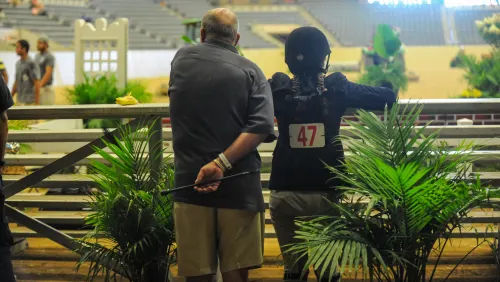Pony breeding in the United States has been on the fast track for the last 20 years. And the development of pony breeding associations has been instrumental in driving the pony breeding industry forward.
The founding of the Virginia Pony Breeders Association has ensured recognition for the owners and breeders of Virginia-bred ponies with an annual awards program for its membership, as well as an annual award to the highest-scoring Virginia-bred pony at the USEF Pony Finals.
In 2002 the Welsh Pony So-ciety began an awards program for the USEF Pony Finals, and in 2005 the Pennsylvania Pony Breeders also established an award for the high-scoring Pennsylvania-bred pony at the USEF Pony Finals. And now a pony breeders association from Florida is working on offering a similar award at the Pony Finals for the high-scoring Florida-bred pony.
But that’s not all. New programs continue to develop for pony breeders and owners, such as the National Pony Hunter Breeding Chamionship Series on the East Coast, presented by the VPBA. This event was developed by a group of pony breeders in Virginia, Maryland, Pennsylvania and New Jersey to recognize quality pony breeding and showcase showing ponies in hand. Pony breeding classes have become a regular part of many USEF-recognized competitions. Devon (Pa.), Upperville (Va.) and Warrenton (Va.) bring out record numbers of pony breeding entries each year.
I’d like to see the USHJA Breeders Committee and the USEF Pony Breeding Sub-Task Force work together to form a USEF/USHJA National Pony Breeding Championship similar to the USEF/Sallie Wheeler Breeding Cham-pionship held each Labor Day weekend.
There is no reason why pony breeding shouldn’t have a true national championship event. It just takes some dedicated people to work with staff to develop the requirements, qualifying system and program needed to showcase this facet of our sport.
It might even be possible to hold this event in conjunction with the USEF Pony Finals each August. This would be a great time for a National Pony Breeding Championship and would also expose the world of pony breeding to a huge number of pony patrons.
ADVERTISEMENT
Every year, the people at Professional Auction Services conduct the pony sale at the USEF Pony Finals, and many of our superstar ponies past and present have been sold this way. Dreamboat, Newsworthy and Who’s Kidding Who are just a few of them.
This sale has continually produced high-selling ponies, including this year’s sale topper at $75,000. In addition, it has created a market for younger ponies who have yet to be broken. The pony sale has become so popular that PAS has added another one to its schedule.
Breeders from all over the country send their ponies to the sale at Pony Finals. I know of several owners who send their ponies in advance of the sale to handlers to have them prepped so that they’re presented at their best.
Yes, a whole industry exists in our country for pony breeding.
And our pony breeders are in a lot better position than their horse-breeding friends. So many people go to Europe to find horses.
But it’s not often that a pony trainer shops for a prospect in Europe for their pony clients, although breeders do travel abroad to purchase breeding stock. The reason is that Europe does produce pony jumpers, but it doesn’t have a compatible system to our pony hunter system. Aren’t our pony breeders lucky!?
Show jumping is a national sport across the pond and a major component of the economies of European countries. Even though horse sports generate more than $100 million each year in the USA, we still must struggle just to get our federal, state, and local governments to support–or even respect–our industry.
ADVERTISEMENT
Breeding and raising horses tends to cost more than ponies, but breeding and raising either is an expensive endeavor. Many competitors don’t realize the hard work and thought breeders put into producing competition ponies, not to mention the hours of anxiety that goes with the process. All the while, you’re praying you have a good one you can sell for enough money to break even–or maybe make a profit.
To develop incentives that help breeders to continue producing ponies for children to ride, we need to be looking at other options to increase awareness of pony breeding in the United States.
Recently, I was approached by Judy Werner on behalf of the American Saddlebred Horse Association to give a hunter clinic to Saddlebred riders in St. Louis. The people I met were all enthusiastic riders with completely open minds. They were like sponges, soaking up the information.
In the course of a couple of two-hour sessions, they’d absorbed enough information to ride in an over fences class and perform admirably. This was exciting for the participants, auditors and for me. It showed me that we should be looking to other breeds and disciplines for ideas and help with some of our programs and initiatives.
We can gain an incredible amount of knowledge and insight by working with other breed and discipline organizations, groups like the American Quarter Horse Association and the International Arabian Horse Association. Both of these associations have very popular incentive programs for their breeders, and we would benefit from their expertise. Colleen McQuay and Robin Greenwood of the USHJA Breeders Committee are already working on plans to create incentive programs for breeders.
Pony breeding is big business already, but it has the ability to become a huge business with the recognition our breeders deserve.
The only way to create programs to help our breeders is for our breeders to get involved and support the efforts of our committees and leaders in advancing their sport.














